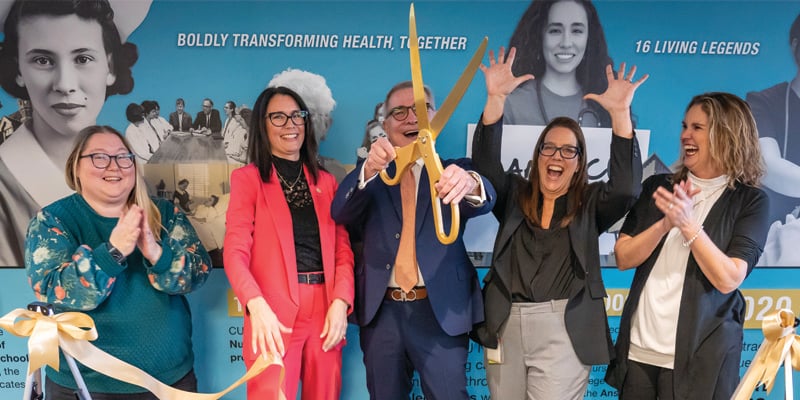Textbooks are no longer the primary source of education in the classroom. CU Nursing includes traditional lectures, simulations, practical clinical experiences, and physical transformations of faculty into patients.
Through the use of “motion picture” grade silicone masks and props, clothing and a bit of acting – CU Nursing faculty are transformed from educators into patients. In the vein of Robin Williams as Mrs. Doubtfire and Tom Cruise in Mission Impossible, the instructor becomes an entirely different person; sharing her story and medical condition with the students. The teaching strategy is called MASK-EDTM and was invented by Professor Kerry Reid-Searl at CQUniversity Australia, specifically for nursing students. Employed by a limited number of programs in the U.S., MASK-EDTM requires a commitment to the technique and a significant amount of training.
The Set-Up
For nursing students, the intrigue begins months in advance at the beginning of the semester with “special guest” highlighted on syllabi. Students assume the guest is part of the learning process. They are unaware that the guest is not just any patient or speaker. The speaker is one of their instructors who has assumed the identity of “Lilly” – complete with a new face, hair, posture, mannerisms, and voice. Unrecognizable to the students, the faculty member takes them on a journey of discovery.
The Transformation
Fast-forward six weeks into the semester.
Fifteen minutes prior to class, CU faculty member Dr. JoAnn Crownover becomes “Lilly”, a retired nurse who now cares for her chronically ill husband. Looking and sounding like no one the students have seen or heard before, Lilly enters the classroom and begins speaking to the class.
With a distinctive voice, posture, and charismatic personality, Lilly captures the students’ attention while sharing her own illness, symptoms, and medications. She expresses concerns about the side effects of her medication regimen. She has the class enthralled, collecting feedback and creating a unique learning environment.
“By transforming into another identity, I become a person with a distinct story that is relevant to the learning experience. This allows me to direct the learning process, guiding the student and responding spontaneously in character to their questions,” says Dr. Crownover.
The Reveal
Intrigued and interested in Lilly’s story and her passion for nursing, the students pepper her with questions. They use what they know about drugs to help her use her medications safely and appropriately.
As the lecture is ending, Lilly simply turns her back to the crowd, removes her mask, turns around and reveals herself as Dr. Crownover.
The reveal never fails to surprise.
“I was genuinely surprised that Lilly was actually Dr. Crownover. The whole class was actively engaged with her and invested in teaching her about medication. It was a great way to take a break from the normal classroom setting and into a new and exciting style of learning,” said Chelsea Triolo, UCAN nursing student.
Lilly plans to pop in and out of future classes. Even though the students know who Lilly really is, she’s still believable. “They know who I am and still fall back into a normal conversation with Lilly. It never feels contrived, unnatural or strained,” says Dr. Crownover.



